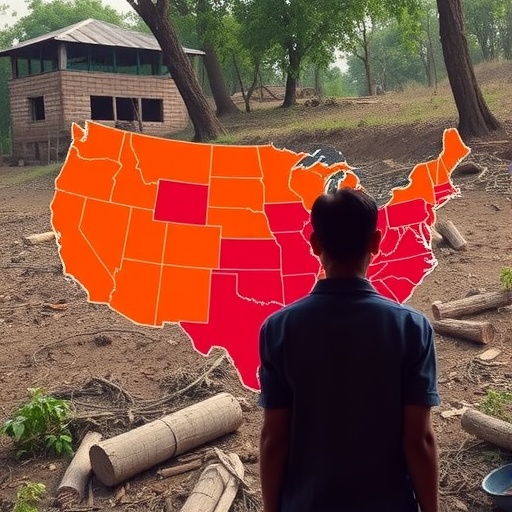In a groundbreaking study published in the Journal of the American Medical Association (JAMA), researchers from Mass General Brigham and the Richard A. and Susan F. Smith Center for Outcomes Research at Beth Israel Deaconess Medical Center have revealed the growing significance of international medical professionals within the United States healthcare system, particularly those sponsored under H-1B visa programs. Their analysis demonstrates that these foreign-trained physicians represent nearly 1% of the entire physician workforce in the U.S. in 2024, underscoring the subtle yet crucial role they play across various demographics and geographic regions.
The investigation delves into the nuanced distribution of H-1B visa-sponsored healthcare workers, uncovering substantial disparities in dependence on these professionals across different counties. From urban centers to remote rural areas, patterns of reliance fluctuate markedly, highlighting an uneven landscape shaped by socioeconomic and geographic factors. The study’s timing coincides with a recent presidential proclamation that dramatically raised the fees associated with H-1B visa applications, igniting debates on the potential repercussions for healthcare access nationwide.
Dr. Michael Liu, MD, MPhil, the study’s lead author and a resident physician at Mass General Brigham, emphasized the stakes involved: the most socioeconomically vulnerable communities stand to suffer the greatest detriments from tightened visa policies. These communities, often grappling with scarce healthcare resources, depend disproportionately on foreign healthcare workers to fulfill critical roles such as primary care and rural healthcare services. This reliance makes them acutely sensitive to any policy shifts affecting the availability of such professionals.
The presidential directive increased the application fees for new H-1B visas from an average of $3,500 to an astronomical $100,000. This nearly 30-fold increase poses a significant financial burden on healthcare employers seeking to recruit international talent, which could exacerbate existing shortages in underserved areas. The study sought to provide empirical insights into how this fee hike might sway the healthcare workforce by analyzing Department of Labor data on H-1B applications for fiscal year 2024.
Quantitatively, the data paint a stark picture. Within the total physician population—over 1.1 million—the number of H-1B-sponsored doctors stood at 11,080, amounting to almost 1% of the workforce. The percentages for other healthcare professionals varied, with advanced practice providers such as nurse practitioners and physician assistants barely exceeding 0.02%, and dentists and other healthcare workers constituting 0.40% and 0.07%, respectively. These figures, though seemingly minor in proportion, reflect essential contributions to the healthcare system’s fabric.
Geographically, the reliance on H-1B visa holders is particularly pronounced in rural counties, where the proportion of internationally sponsored physicians is nearly double that observed in urban areas. Furthermore, the counties exhibiting the highest poverty rates show nearly four times greater dependency on these professionals compared to their wealthier counterparts. This geographic and socioeconomic correlation suggests that any reduction in foreign healthcare labor could disproportionately destabilize healthcare delivery in the most vulnerable regions.
The research frames these findings within the broader context of ongoing policy proposals and debates. Senior author Dr. Rishi Wadhera, MD, MPP, MPhil, who serves as Associate Director of the Smith Center, advocates for targeted exemptions from the recent visa fee increases for healthcare workers, especially physicians. He argues that such exemptions would not only preserve vital staffing levels but also safeguard access to timely and high-quality care for millions of Americans.
By employing an observational study design, the researchers utilized comprehensive H-1B visa application data from the Department of Labor, meticulously aggregated at the county level to reveal intricate employment patterns. This rigorous approach enables policymakers and healthcare leaders to quantify potential impacts and strategically plan responses to workforce challenges exacerbated by policy changes.
The timing of these revelations is critical, as the healthcare sector faces growing pressures from population aging, increasing chronic disease prevalence, and ongoing healthcare disparities. The infusion of international medical personnel serves to alleviate some of these systemic stresses, particularly in underserved and rural communities where recruitment of domestic practitioners is fraught with difficulty.
This study also implicitly highlights the interconnectedness of immigration policy and healthcare infrastructure. The recent fee increase is not merely a bureaucratic adjustment but a lever with the capacity to reshape healthcare delivery frameworks across the nation. Understanding and quantifying the workforce dependencies on H-1B visa holders provide an evidence base critical for informed policymaking.
In light of these insights, the researchers call on stakeholders to consider the broader implications of visa policy decisions beyond mere fiscal metrics. The health outcomes of vulnerable populations, equitable access to care, and the sustainability of rural health systems hinge on maintaining a diverse and internationally supported workforce.
Future research avenues may include longitudinal assessments post-policy implementation to empirically track shifts in workforce composition and health service availability. Moreover, exploring alternative policy instruments that balance regulatory objectives with the healthcare system’s needs could foster a more resilient and responsive framework.
Ultimately, this comprehensive investigation sheds light on the indispensable role of internationally sponsored healthcare professionals. It provides a clarion call for nuanced policy measures that protect both the integrity of the U.S. healthcare workforce and the health of communities that depend on it most.
Subject of Research: People
Article Title: Health Care Professionals Sponsored for H-1B Visas in the United States
News Publication Date: 29-Oct-2025
Web References: http://dx.doi.org/10.1001/jama.2025.20931
References: Liu M et al. “Health Care Professionals Sponsored for H-1B Visas in the United States” JAMA DOI: 10.1001/jama.2025.20931
Keywords: Health care policy, Health and medicine




